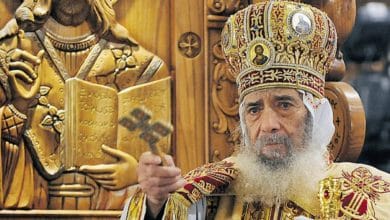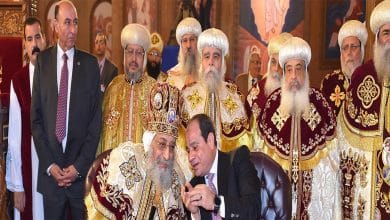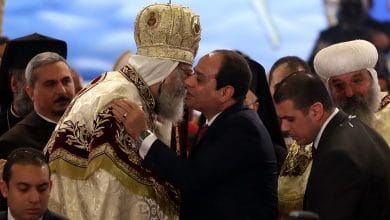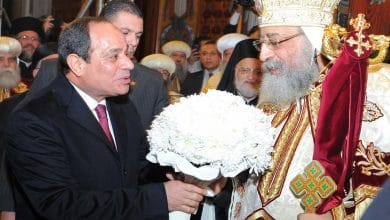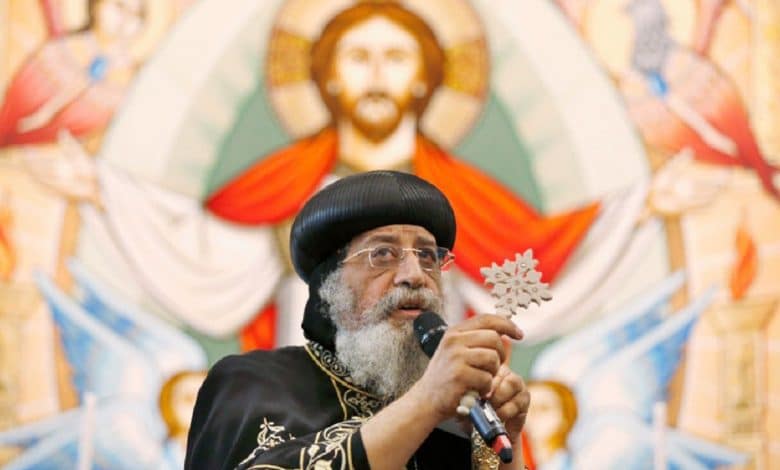
According to several leaders and followers of the Egyptian Coptic Orthodox Church, the Coptic Church is currently living its golden age under Sisi, given the privileges that the Sisi regime has offered to the Church in return for having its support both at home and abroad.
In fact, the Egyptian Orthodox Church has been living its golden age since the beginning of the Mubarak era, and not just during the Sisi era.
The church is no longer just a place of worship, asceticism in worldly matters, and pursuit of salvation in the hereafter, but it has turned into a place for execution of profitable investment projects and performance of political and popular roles, so that we can say, without being accused of exaggeration, that the church has become an empire or at least an independent state within the Egyptian state, with which only the Egyptian military institution can compete in such position.
This paper addresses the features of this ecclesiastical state, and attempts to uncover the extent of its transgressions and infringement on the rights of the homeland and Egyptian citizens.
Allegations of persecution of Copts
Most of the talk about the persecution of Copts that are promoted, rightly or wrongly, overwhelmingly address three areas of persecution: physical violence against Copts, church building, and political representation.
Most of the physical violence has been associated with building unlicensed churches. The writer also handled incidents of violence against Copts in a previous part of this study, drawing the attention to the fact that the ruling regime in Egypt uses Copts to achieve its interests, and that the regime is accused of fueling many incidents of violence against Copts so that they may continue to seek the government’s protection and thus ensure their loyalty to the regime[1].
The Coptic Church’s Economic Empire
However, no one talks about the economic activity of the Copts or the Church in Egypt or attempt to describe the social conditions of Copts as “persecution”, as they usually say it. It is impossible to find a monk or priest demanding equality between the Coptic endowments and the Muslim endowments, or to talk about the need for financial transparency regarding the church’s funds with respect to its relationship with the Egyptian state.
The reason for this (impossibility) is that everyone knows that the Church as an institution, or the Coptic elite, are considered fortunate, so to speak, with respect to wealth and money, and that claims of persecution in this regard would require a high level of audacity to allege.
Some statistics indicate that during the first decade of the twentieth century, Copts that represented about 7% of Egyptian population controlled 20% of the country’s wealth, 45% of government jobs, and 40% of government salaries. Being aware of this fact, former President Gamal Abdel Nasser nationalized (confiscated) most of the Coptic hospitals and schools to become state property, and according to the Agrarian Reform Law issued by Nasser, ownership of lands was restricted to 200 feddans (acres).[2]
In his book, “On the Coptic Question: Facts and Illusions”, Al-Shorouk edition, 2001, Dr. Mohamed Emara provided important statistics about the size of the Copts’ fortunes compared to the rest of the Egyptian people, saying:
“Given the fact that economy is the backbone of life, and that distinguished professions secure the real privileges in society, figures – which never lie – say that the Coptic minority that does not exceed three million is the actual ruler in Egyptian society – where there are sixty millions of Muslims! It suffices to learn that the Copts own and represent the following:
– 22.5% of the companies established between 1974 and 1995;
– 20% of construction companies in Egypt;
– 0,5% of consulting firms;
– 60% of pharmacies;
– 45% of private medical clinics;
– 35% of membership of the American Chamber of Commerce … and the German Chamber of Commerce;
– 60% of membership of the French Chamber of Commerce (Egyptian-French Businessmen Forum);
– 20% of Egyptian businessmen;
– 20% of positions of managers in sectors of economic activity in Egypt.
– More than 20% of investors in the new cities of Sadat and Tenth of Ramadan ..
– 09 15% of jobs at the Egyptian Ministry of Finance.
– 25% of the excellent and distinguished professions – pharmacists, doctors, engineers, lawyers, and veterinarians.
That is, 9. 5 of Egypt’s population – the Copts – own between 35% and 40% of Egypt’s wealth and privileges?[3]
Note that these percentages and figures describe the situation of Copts until 2001, that is, nearly twenty years ago; and you can imagine the size of the change in these percentages and figures at present after the tremendous support for the Church by the regime, that the study addressed in a previous part.
In addition, the above figures relate to the Copts in general, not to the Egyptian Church as an institution and its funds, which categorically reject any supervision by the state’s audit and accountability agencies.
Abdel-Masih Baseet, a priest at the Church of the Virgin and one of the leaders of the Coptic Church says: “The church cannot allow the state to control its finances because its donations are considered its own money, not public money, as there is a Coptic endowment body responsible for it,” as he puts it.[4]
Rather, the former acting Patriarch of the Coptic Church, Anba Pachomius, rejected state control over the Church’s financial resources and considered it as “outright persecution of Copts” under the pretext that donations received by the Church are “private funds” that should not be subject to such control.[5]
To understand the reason behind the absolute rejection of the Church leadership of the state’s auditing like other state institutions, Coptic thinker Paul Ramzi says that “overseeing church funds is a right of the state. The Church funding sources are estimated at billions annually in the form of tithes, internal and external donations, vows, and remittances of diaspora Copts.
According to the Ecclesiastical Reform Front, which opposes Coptic Church management, the Church owns thousands of real estate and feddans, as well as hundreds of hospitals and schools that are run under the names of Coptic businessmen in various governorates of Egypt, the proceeds of which are divided among senior members of the Holy Synod and priests.[6]
Note that the paper deliberately cited Copts so that no one would accuse the writer of exaggeration or forgery[7]. In view of the above statements, it is clear that the Egyptian Orthodox Church is considered a sovereign state, immune from accountability or state control, closed behind its high walls, which makes it and its subjects a parallel society that is different from the one on the other side.
The state of the ecclesiastical monasteries
A major and important part of the empire of the Egyptian Church – some of whose leaders or parishes both at home and abroad do not cease to allege existence of “religious persecution” in Egypt and recall it whenever necessary – is represented by the system of monasteries and monasticism spread across Egypt.
The monastery in principle is a place of worship and asceticism in the worldly matters, but in the Egyptian case the monastery is a large complex of commercial activities that export their products both at home and abroad!!
A study by Hussein Abu Issa, the lawyer in Court of Cassation and former advisor to the military courts, in March 2014 revealed that “the largest monastery in Egypt is the monastery of Anba Maqar in Minya, with an area of about 2,700 feddans, equivalent to approximately 11 million and 340 thousand square meters, which, that accommodates a minimum of about 11 million and 340 thousand worshipers, and a maximum of about 24 million worshipers, based on international standards, which is about twice the number of Copts in Egypt.
The study added that the area of Anba Maqar Monastery is equivalent to 25 times the area of the Vatican State, which has an area of only 440,000 square meters.
The study also said that by comparing the Anba Maqar Monastery with the largest Mosque for Muslims in the world, that is the Holy Mosque at Makkah, it has come out that the area of the Holy Mosque is about 356,000 square meters, that accommodates about 773,000 worshipers, which means that the area of the Anba Maqar Monastery is more than 15 times larger than the area of the Holy Mosque at Makkah.
The second largest monasteries, according to the study, is the Monastery of Abu Fana in Minya, whose area is about 600 feddans, equivalent to 2 million and 520 thousand square meters, that can accommodate a minimum of 2.5 million worshipers and a maximum of 5.5 million worshipers.[8]
These are the enormous areas for only two of these monasteries, estimated at tens[9], established on hundreds and even thousands of feddans, according to various sources.
Also, these monasteries, especially the large ones, which are many as mentioned above, “include a number of factories for producing cheese, pickles, juices; bakeries; carpentry workshops; blacksmithing; and pharmacies. They also have huge farms that grow all kinds of crops and fruits, as well as large farms for raising cows, birds and pigs for production of meat, cheese and oils such as Olive oil. Monasteries also have health facilities and independent water resources, as there are several giant tanks for drinking water sufficient to cover the needs of entire neighborhoods of water; in addition to capability of generating electricity as well[10].
The impact of this economic activity on the state and society
These large economic activities of monasteries, as well as churches and service buildings affiliated with them, cause several problems with the state and the Egyptian citizens in general, including:
– The state treasury’s annual loss of billions of pounds in taxes due to absence of any control or supervision over these monasteries by the state.
– The prices of products of these monasteries are much lower than their counterparts in Egyptian society due to absence of any taxes or fees, which results in a state of monopoly of goods produced in monasteries because there are fees and taxes added to their counterparts in the Egyptian society, and thus the rights of tens of thousands of workers in such industries are violated.
– These economic activities contribute to increasing the isolation of the Copts from the rest of the Egyptian people, where the Church state becomes responsible for all their spiritual and material needs; and expulsion from this state becomes a hell for the average Coptic citizen.
– This apparent discrimination in favor of the Copts in Egypt leads to a state of tension among the Muslim majority because of their sense of injustice by the unfairly distinguished minority, through their power to impose a fait accompli and blackmail, exploiting their allegations of religious persecution and seeking support from Western countries.
This makes it easy to ignite and escalate any normal disagreement between Muslims and Copts up to the level of sectarian strife due to tension factors that are increasing day after day.
In such situation, the Egyptian citizen finds himself besieged between two favored groups, namely the military and security institutions on the one hand, and the Church and its monasteries on the other: while the interests of both parties converge, the simple citizen is crushed between them.
The share of poor Copts of this wealth
However, this enormous wealth owned by the Church and monasteries, estimated at tens of billions annually[11], have failed to eliminate poverty and destitution among the Coptic citizens.
This confirms what this study had previously stated that the lucky ones are the “Coptic elite” and not ordinary citizens, with respect to this wealth. Therefore, it has become normal to read in Egyptian newspapers or social media platforms news reports like the following:
– A judicial dispute between a Coptic Orthodox nun and a monk in the Anba Maqar Monastery , in Wadi al-Natrun, over the ownership of a villa in Mokattam, Cairo, where the nun says that she had bought it in March 2005 for 450 thousand Egyptian pounds, according to Rose Al-Youssef magazine in 2006.[12]
– Another news item, published in December 2018, including details about spending 300 thousand pounds on the funeral of a deceased priest, whose son works as a scout leader at the Virgin Church, Fagalah, Cairo, out of the money of the poor.[13]
On the other side, there are dozens of cases of Coptic citizens that ended up with theft or committing suicide due to poverty, including:
– Ashraf Saber Salib (38), whose suicide story by hanging himself in the neighborhood 40, in the Tenth of Ramadan city, in Sharqia governorate, shocked the public opinion, because of what was said about the financial distress that he had gone through, and that he had sought help from the Anba Maqar Church, and also through begging from neighbors and friends, but to no avail.
– Also, Farag Rizk Farag (48) was found dead after hanging himself on one of the huge “Long Live Egypt” paintings overlooking the Cairo-Ismailia desert road, after he had also gone through a financial crisis and was unable to meet the demands of his family and children at school.
– However, the condition of the nine-year-old child, Abdel-Masih Ezzat Aziz, is the most severe cases of poverty, where he had been imprisoned for a year for stealing 5 loaves of bread from a bakery next to his home in the Al-Fashn, Beni Suef.[14]
Conclusion
It has become apparent that the talk about “Persecution of Copts” in Egypt is a groundless allegation. Rather, the opposite is true, based on proven evidence, of which this paper has only stated some.
Also, it has been understandable why the Church had been strongly hostile to the late Egyptian President Mohamed Morsi and the 2012 Constitution that was due to pave the way for state oversight over its financial and economic activity; and how the interests of the army and the Church converged, making them unite to eliminate the nascent democratic state on 3 July 2013.
Footnotes
[1] Egyptian Institute of Studies: To read the previous parts of the study, follow this link.
[2] Karoline Kamel, Will the laity save the Coptic Church?, Mada Masr, 18 November 2018, accessed 23 September 2020, Link.
[3] The figures presented by Dr. Mohamed Emara in his book cited: “Rose Al-Youssef” report; the “Union of Medical Professions”; the “Contractors Union”; the Al-Mokhtar Al-Islami magazine, issue 15 Rabie pAl-Awal 1419 AH – July 1998 AD; Gamal Badawi’s (Sectarian Strife) P. 116, Cairo edition, 1992 – that cites Dr. Samira Bahr’s (The Copts in Egyptian Political Life) and Dr. Mohamed Emara’s (On the Coptic Question … Facts and Illusions), p. 88, Al-Shorouk edition, 2001 AD.
[4] The Coptic Church in Egypt rejects state control over its funds, Anadolu Agency, 28 August 2012, accessed 22 September 2020, Link.
[5] Ibid.
[6] Ibid.
[7] The church leadership decided to expel those who demand state oversight of the church’s funds from “Mercy of the Lord” which was done to the priest Ibrahim Abdel-Sayed, where all churches refused to hold a Mass or pray for him after his death because of the papal decree denying him that, according to the priest’s wife.
[8] – The Orthodox Church in Egypt .. How did it become above the Constitution and laws?, al-Estiklal, accessed 19 September 2020, Link.
[9] The struggle of the Coptic Church with the monasteries outside its authority, al-Quds al-Arabi, 19 August 2018, accessed 23 September 2020, Link. (The Coptic Church recognizes ownership of only forty monasteries, 27 of which are for monks and 13 for nuns, in addition to 13 under foundation and 12 farms under the supervision of bishops.)
[10] The secret file of the monasteries’ wealth, El-Mogaz, 27 August 2018, accessed 23 September 2020, Link.
[11] The Coptic Church in Egypt rejects state control over its funds, Op. Cit.
[12] Copts and Politics, Gamal Sultan, Dar al-Ilm Wal-Iman, p. 5
[13] The funeral of a monk costs 300 thousand pounds, Copts of America, accessed 22 September 2020, Link.
[14] The Church’s Economic Empire … Record Numbers and Societal Dangers, The Political Street, 2 January 2019,accessed 18 September 2020, Link.
